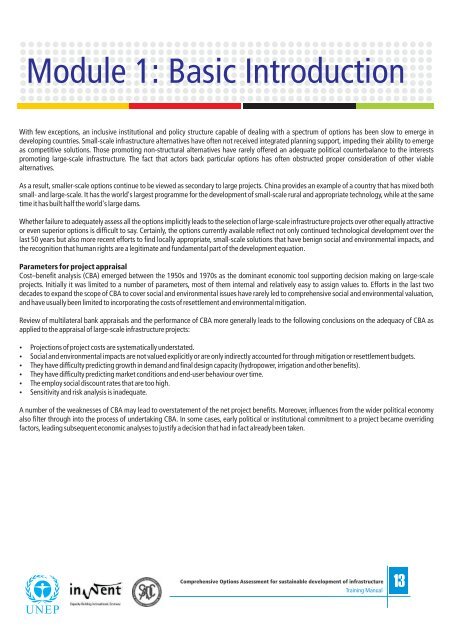Comprehensive Option Assesment - UNEP
Comprehensive Option Assesment - UNEP
Comprehensive Option Assesment - UNEP
You also want an ePaper? Increase the reach of your titles
YUMPU automatically turns print PDFs into web optimized ePapers that Google loves.
Module 1: Basic Introduction<br />
With few exceptions, an inclusive institutional and policy structure capable of dealing with a spectrum of options has been slow to emerge in<br />
developing countries. Small-scale infrastructure alternatives have often not received integrated planning support, impeding their ability to emerge<br />
as competitive solutions. Those promoting non-structural alternatives have rarely offered an adequate political counterbalance to the interests<br />
promoting large-scale infrastructure. The fact that actors back particular options has often obstructed proper consideration of other viable<br />
alternatives.<br />
As a result, smaller-scale options continue to be viewed as secondary to large projects. China provides an example of a country that has mixed both<br />
small- and large-scale. It has the world's largest programme for the development of small-scale rural and appropriate technology, while at the same<br />
time it has built half the world's large dams.<br />
Whether failure to adequately assess all the options implicitly leads to the selection of large-scale infrastructure projects over other equally attractive<br />
or even superior options is difficult to say. Certainly, the options currently available reflect not only continued technological development over the<br />
last 50 years but also more recent efforts to find locally appropriate, small-scale solutions that have benign social and environmental impacts, and<br />
the recognition that human rights are a legitimate and fundamental part of the development equation.<br />
Parameters for project appraisal<br />
Cost–benefit analysis (CBA) emerged between the 1950s and 1970s as the dominant economic tool supporting decision making on large-scale<br />
projects. Initially it was limited to a number of parameters, most of them internal and relatively easy to assign values to. Efforts in the last two<br />
decades to expand the scope of CBA to cover social and environmental issues have rarely led to comprehensive social and environmental valuation,<br />
and have usually been limited to incorporating the costs of resettlement and environmental mitigation.<br />
Review of multilateral bank appraisals and the performance of CBA more generally leads to the following conclusions on the adequacy of CBA as<br />
applied to the appraisal of large-scale infrastructure projects:<br />
Projections of project costs are systematically understated.<br />
Social and environmental impacts are not valued explicitly or are only indirectly accounted for through mitigation or resettlement budgets.<br />
They have difficulty predicting growth in demand and final design capacity (hydropower, irrigation and other benefits).<br />
They have difficulty predicting market conditions and end-user behaviour over time.<br />
The employ social discount rates that are too high.<br />
Sensitivity and risk analysis is inadequate.<br />
A number of the weaknesses of CBA may lead to overstatement of the net project benefits. Moreover, influences from the wider political economy<br />
also filter through into the process of undertaking CBA. In some cases, early political or institutional commitment to a project became overriding<br />
factors, leading subsequent economic analyses to justify a decision that had in fact already been taken.<br />
<strong>Comprehensive</strong> <strong>Option</strong>s Assessment for sustainable development of infrastructure<br />
Training Manual<br />
13
















